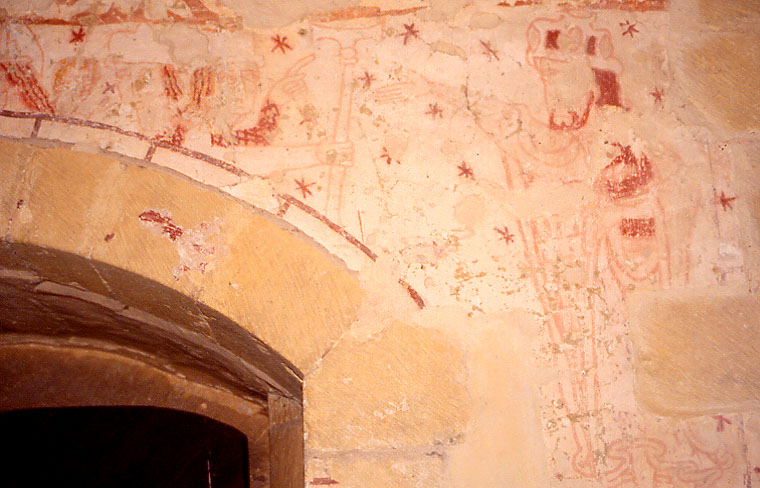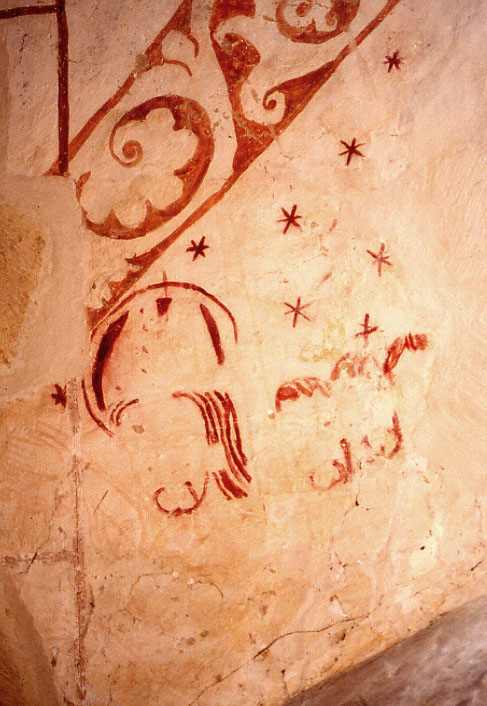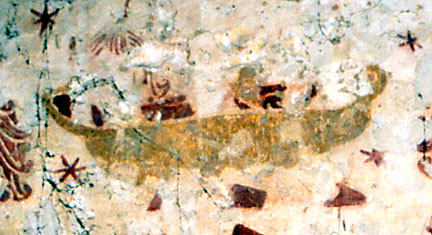Stoke Orchard, Gloucestershire (†Gloucester) C.12
Life of St James the Great

The detail at the left shows one of the few fairly clear areas in the early but badly damaged and faded Life of St James at Stoke Orchard. The incident presented comes from the end of the Saint’s legend¹, which was once painted in considerable detail on all the walls of the church. At this point in the complicated story, James, by superior magic, has emerged triumphant from his encounter with the pagan enchanter Hermogenes, who was treated by James thereafter with great magnanimity. The man holding out a staff at the centre left is Hermogenes’s son, Philetus, already converted by James. Hermogenes himself, a large figure in the kind of ‘eastern’ hat which so frequently signifies heathenism, stands at the right extending his hand to receive the staff, which will protect him from the devils who have brought him to James.

Unfortunately no clear detail of the saint himself has survived, and that shown at the left is the least obscure. Enough remains (left of picture) to show the outline of James’s head, halo and what looks like a bishop’s mitre – if so, it might have been bestowed on him by the painter simply as a sign of eminence, or possibly by confusion with St James the Less, first bishop of Jerusalem. His hands, extended to the left in prayer, also show in outline. He is baptizing converts here, and what is left of three of their heads is at the right. The starry background found in all the scenes, and the elaborate border surrounding them, also shows here. These borders, some of them incorporating serpents’ heads in the stylized foliage, are remarkable in themselves.
The theme of the vanquishing of pagan magic is found throughout the painted series, and in the scene below at the right this is manifested in the falling of the idols worshipped by the pagans.
The idols are the semi-recumbent figures at the left, shown in the act of falling. The lower one (in the cross-hatched robe) has notably curling, unruly hair, invariably a sign of evil purpose of some kind. James, in the centre, has been reduced again to halo, mitre and hair (straight), but he is holding his staff in his left hand and this is just discernible. The figure at the right, with a very large halo and gently waving long hair, is Christ, blessing James’s work.

Most of the other scenes are now too fragmentary to be anything other than confusing in reproduction, but one detail is a little clearer. This is a boat, painted in yellow, (detail below left) and with at least three figures on board.
According to Clive Rouse, these are James, the now-converted Hermogenes and Philetus, who were towards the end of the story put in the boat and cast adrift, but by whom is not clear. I cannot find a source for this idea, but various versions of the legend include a boat, the least incredible claiming that James’s body, after his beheading in Judaea under Herod Agrippa, was taken by his followers first to the Mediterranean port of Joppa and then in a boat (made of marble) by miraculous agency to Spain, where his famous shrine at Compostela remains. Marble or not, the pictured boat resembles very closely the kind of coracle, made rather more practically of leather and withies, used on the nearby river Severn since time immemorial.

Most English church paintings of St James, including all those now on the site, show him as a straightforward standing figure, sometimes accompanied by others, as at Wisborough Green. A few narrative Lives of the saint are recorded though, notably at Guildford in Surrey and Little Kimble in Buckinghamshire, but both are later than the Stoke Orchard example. For other paintings of various subjects but comparably early date, follow the link at the top left of this page.
¹ The Golden Legend of Jacobus da Voragine is the usual source for this kind of story, but Clive Rouse, who saw and drew copies of these paintings when they were in a better state, noticed that there are details in them not found in the Legend, which in any case post-dates them. One likely alternative source is the Pseudo-Abdias, an earlier collection of saints’s lives accepted as authoritative by the Church. Appropriate parts of it were certainly read in churches on saints’ days, from the 12th century at least Emile Mâle (Religious Art in France, XIII century, pp. 295) cites a 12th century lectionary which includes the Life of St James as taken from the pseudo-Abdias [Bibliotheque Sainte-Geneviéve, MS 132, f.127 v.]. Another possible source is the homilist Aelfric, first Abbot of Eynsham from 1005. Aelfric’s Homily 27 (Aelfric’s Catholic Homilies, second series, EETS, n.s.5, London, 1979) is cited by JB Russell in Lucifer: The Devil in the Middle Ages, (Cornell, 1984 p. 158 fn ) as containing the Hermogenes story, but whether Aelfric’s Homilies were still being used by priests after the Norman Conquest I do not know.